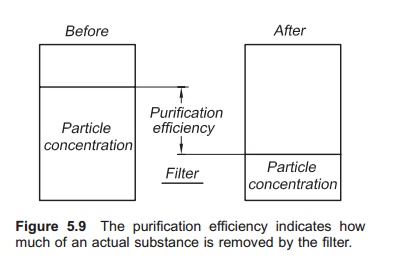Chapter: Aquaculture Engineering : Removal of Particles
Purification efficiency - Aquaculture Engineering
Purification
efficiency
As shown, there are several methods for removing particles from
a water flow. To evaluate how effectively a filter is functioning and to
compare filter systems, the term purification efficiency is commonly used (Fig.
5.9). This can be defined as follows:
Ce=((Cin−Cout)/Cin)×100
where:
Ce=efficiency (%)
Cin=concentration of the actual substance enter-ing the filter
Cout=concentration of the actual substance exitingthe filter.

Example
The concentration of suspended solids
entering the filter units is measured and found to be 20 mg/l; on exiting the
filter the concentration is measured as 5 mg/l. Find the purification
efficiency of the filter.
Ce=((Cin−Cout)/Cin)×100
=((20 − 5)/20) × 100 = 75%
In aquaculture the efficiency is normally ex-pressed as the
percentage of the incoming TSS removed by the filter. However, it may also be
used for other substances, such as the amount of removed nutrients (total
phosphorus, TP or total nitrogen, TN) or as reduction in chemical oxygen demand
(COD) or biological oxygen demand (BOD) in the water passing through the
filter. The last two measurements tell us how the outlet water will affect the
oxygen concentration in the recipient water body.
When considering removal of nutrients, it is important to know
the proportion attached to par-ticles and not dissolved, since it is not
possible to remove dissolved nutrients with a particle filter. These values
depend on the species and the feed composition and utilization. Experiments on
salmonids have shown that more than 80% of nitro-gen compounds are dissolved in
the water, whereas the situation is reversed for phosphorus with up to 80%
being attached to particles. However, phosphorus leach easily from particles
lying in the water; this is a major reason to remove the particles from the
water flow as quickly as possible.
The efficiency of the particle filter of course depends on the
particle concentration and characteristics of the water to be purified. For a
good comparison of filter systems, they must be tested on exactly the same
water. Typical values for removal of TSS from wastewater from fish farming
range from 30 to 80% while some lower values have been
reported for water re-use systems.
Related Topics